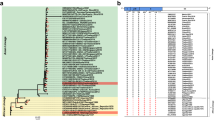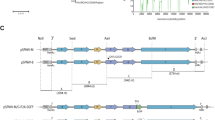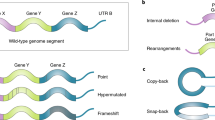Abstract
Borna disease virus (BDV) is an enveloped virus that has a non-segmented, negative-strand RNA genome with the characteristic organization of the mononegaviruses. However, based on its unique genetic and biological features, BDV is considered to be the prototypic member of a new mononegavirus family, the Bornaviridae. BDV causes central nervous system (CNS) disease in a wide variety of mammals. This article discusses the recently developed reverse-genetics systems for BDV, and the implications for the elucidation of the molecular mechanisms underlying BDV–host interactions, including the basis of BDV persistence in the CNS and its associated diseases.
This is a preview of subscription content, access via your institution
Access options
Subscribe to this journal
Receive 12 print issues and online access
$209.00 per year
only $17.42 per issue
Buy this article
- Purchase on Springer Link
- Instant access to full article PDF
Prices may be subject to local taxes which are calculated during checkout




Similar content being viewed by others
References
Rott, R. & Becht, H. in Borna Disease (eds Koprowski, H. & Lipkin, W. I.) 17–30 (Springer, Berlin, 1995).
Staeheli, P., Sauder, C., Hausmann, J., Ehrensperger, F. & Schwemmle, M. Epidemiology of Borna disease virus. J. Gen. Virol. 81, 2123–2135 (2000).
Ikuta, K., Hagiwara, K., Taniyama, H. & Nowotny, N. in Borna Disease Virus and its Role in Neurobehavioral Disease (ed. Carbone, K. M.) 87–124 (ASM Press, Washington DC, 2002).
Richt, J. A. & Rott, R. Borna disease virus: a mystery as an emerging zoonotic pathogen. Vet. J. 161, 24–40 (2001).
Flower, R. & Kamhieh, S. Letter to the Editor refuting 'Epidemiological pattern of classical Borna disease and regional genetic clustering of Borna disease viruses point towards the existence of to-date unknown endemic reservoir host populations' by Ralf Durrwald, Jolanta Kolodziejek, Aemero Muluneh, Sibylle Herzog and Norbert Nowotny. Microbes Infect. 8, 1419–1420 (2006).
Durrwald, R., Kolodziejek, J. & Nowotny, N. Borna disease virus (BDV) sequences derived from plasma samples of Australian cats contain multiple sequencing errors and are otherwise almost identical to strain V, a commonly used BDV laboratory strain. Microbes Infect. 8, 1421–1422 (2006).
Durrwald, R., Kolodziejek, J., Muluneh, A., Herzog, S. & Nowotny, N. Epidemiological pattern of classical Borna disease and regional genetic clustering of Borna disease viruses point towards the existence of to-date unknown endemic reservoir host populations. Microbes Infect. 8, 917–929 (2006).
Nowotny, N. et al. Isolation and characterization of a new subtype of Borna disease virus. J. Virol. 74, 5655–5658 (2000).
Hilbe, M. et al. Shrews as reservoir hosts of borna disease virus. Emerg. Infect. Dis. 12, 675–677 (2006).
Pletnikov, M., Gonzalez-Dunia, D. & Stitz, L. in Borna Disease Virus and its Role in Neurobehavioral Disease (ed. Carbone, K. M.) 125–178 (ASM Press, Washington DC, 2002).
Pletnikov, M. V., Moran, T. H. & Carbone, K. M. Borna disease virus infection of the neonatal rat: developmental brain injury model of autism spectrum disorders. Front. Biosci. 7, D593–D607 (2002).
Gonzalez-Dunia, D., Sauder, C. & de la Torre, J. C. Borna disease virus and the brain. Brain Res. 44, 647–664 (1997).
Gonzalez-Dunia, D. et al. Synaptic pathology in Borna disease virus persistent infection. J. Virol. 74, 3441–3448 (2000).
Hornig, M., Solbrig, M., Horscroft, N., Weissenbock, H. & Lipkin, W. I. Borna disease virus infection of adult and neonatal rats: models for neuropsychiatric disease. Curr. Top. Microbiol. Immunol. 253, 157–177 (2001).
Hornig, M., Weissenbock, H., Horscroft, N. & Lipkin, W. I. An infection-based model of neurodevelopmental damage. Proc. Natl Acad. Sci. USA 96, 12102–12107 (1999).
Lipkin, W. I., Hatalski, C. G. & Briese, T. Neurobiology of Borna disease virus. J. Neurovirol. 3, S17–S20 (1997).
Weissenbock, H., Hornig, M., Hickey, W. F. & Lipkin, W. I. Microglial activation and neuronal apoptosis in Bornavirus infected neonatal Lewis rats. Brain Pathol. 10, 260–272 (2000).
Planz, O., Bechter, K., and Schwemmle, M. in Borna Disease Virus and its Role in Neurobehavioral Disease (ed. Carbone, K. M.) 179–226 (ASM Press, Washington DC, 2002).
Carbone, K. M. Borna disease virus and human disease. Clin. Microbiol. Rev. 14, 513–527 (2001).
Billich, C. et al. High-avidity human serum antibodies recognizing linear epitopes of Borna disease virus proteins. Biol. Psychiatry 51, 979–987 (2002).
Briese, T. et al. Genomic organization of Borna disease virus. Proc. Natl Acad. Sci. USA 94, 4362–4366 (1994).
Cubitt, B., Oldstone, C. & de la Torre, J. C. Sequence and genome organization of Borna disease virus. J. Virol. 94, 1382–1396 (1994).
de la Torre, J. C. Molecular biology of Borna disease virus: prototype of a new group of animal viruses. J. Virol. 94, 7669–7675 (1994).
Schneemann, A., Schneider, P. A., Lamb, R. A. & Lipkin, W. I. The remarkable coding strategy of borna disease virus: a new member of the nonsegmented negative strand RNA viruses. Virology 95, 1–8 (1995).
Kohno, T. et al. Fine structure and morphogenesis of Borna disease virus. J. Virol. 73, 760–766 (1999).
Gosztonyi, G. & Ludwig, H. in Borna Disease (eds Koprowski, H. & Lipkin, W. I.) 39–74 (Springer, Berlin, 1995).
Whelan, S. P. S., Barr, J. N. & Wertz, G. W. in Biology of Negative Strand RNA Viruses: the Power of Reverse Genetics (ed. Kawaoka, Y.) 61–119 (Springer, Berlin, 2004).
Conzelmann, K. K. Reverse genetics of mononegavirales. Curr. Top. Microbiol. Immunol. 283, 1–41 (2004).
Perez, M., Sanchez, A., Cubitt, B., Rosario, D. & de la Torre, J. C. A reverse genetics system for Borna disease virus. J. Gen. Virol. 84, 3099–3104 (2003).
Perez, M. & de la Torre, J. C. Identification of the Borna disease virus (BDV) proteins required for the formation of BDV-like particles. J. Gen. Virol. 86, 1891–1895 (2005).
Schneider, U. Novel insights into the regulation of the viral polymerase complex of neurotropic Borna disease virus. Virus Res. 111, 148–160 (2005).
Schneider, U., Naegele, M., Staeheli, P. & Schwemmle, M. Active borna disease virus polymerase complex requires a distinct nucleoprotein-to-phosphoprotein ratio but no viral X protein. J. Virol. 77, 11781–11789 (2003).
Pyper, J. M. & Gartner, A. E. Molecular basis for the differential subcellular localization of the 38- and 39-kilodalton structural proteins of Borna disease virus. J. Virol. 71, 5133–5139 (1997).
Rudolph, M. G. et al. Crystal structure of the borna disease virus nucleoprotein. Structure 11, 1219–1226 (2003).
Wehner, T. et al. Detection of a novel Borna disease virus-encoded 10 kDa protein in infected cells and tissues. J. Gen. Virol. 78, 2459–2466 (1997).
Schwardt, M. et al. The negative regulator of Borna disease virus polymerase is a non-structural protein. J. Gen. Virol. 86, 3163–3169 (2005).
Gonzalez-Dunia, D., Cubitt, B., Grasser, F. A. & de la Torre, J. C. Characterization of Borna disease virus p56 protein, a surface glycoprotein involved in virus entry. J. Virol. 71, 3208–3218 (1997).
Richt, J. A. et al. Processing of the Borna disease virus glycoprotein gp94 by the subtilisin-like endoprotease furin. J. Virol. 72, 4528–4533 (1998).
Kiermayer, S., Kraus, I., Richt, J. A., Garten, W. & Eickmann, M. Identification of the amino terminal subunit of the glycoprotein of Borna disease virus. FEBS Lett. 531, 255–258 (2002).
Eickmann, M. et al. Maturation of Borna disease virus glycoprotein. FEBS Lett. 579, 4751–4756 (2005).
Poch, O., Blumberg, B. M., Bougueleret, L. & Tordo, N. Sequence comparison of five polymerases (L proteins) of unsegmented negative-strand RNA viruses: theoretical assignment of functional domains. J. Gen. Virol. 71, 1153–1162 (1990).
Tordo, N., DeHaan, P., Goldbach, R. & Poch, O. Evolution of negative-stranded RNA genomes. Semin. Virol. 3, 341–357 (1992).
Gonzalez-Dunia, D., Cubitt, B. & de la Torre, J. C. Mechanism of Borna disease virus entry into cells. J. Virol. 72, 783–788 (1998).
Perez, M., Watanabe, M., Whitt, M. A. & de la Torre, J. C. N-terminal domain of Borna disease virus G (p56) protein is sufficient for virus receptor recognition and cell entry. J. Virol. 75, 7078–7085 (2001).
Cubitt, B. & de la Torre, J. C. Borna disease virus (BDV), a nonsegmented RNA virus, replicates in the nuclei of infected cells where infectious BDV ribonucleoproteins are present. J. Virol. 68, 1371–1381 (1994).
Cros, J. F. & Palese, P. Trafficking of viral genomic RNA into and out of the nucleus: influenza, Thogoto and Borna disease viruses. Virus Res. 95, 3–12 (2003).
Goldfarb, D. S., Corbett, A. H., Mason, D. A., Harreman, M. T. & Adam, S. A. Importin α: a multipurpose nuclear-transport receptor. Trends Cell Biol. 14, 505–514 (2004).
Kobayashi, T. et al. Nuclear targeting activity associated with the amino terminal region of the Borna disease virus nucleoprotein. Virology 243, 188–197 (1998).
Shoya, Y. et al. Two proline-rich nuclear localization signals in the amino- and carboxyl-terminal regions of the Borna disease virus phosphoprotein. J. Virol. 72, 9755–9762 (1998).
Wolff, T., Unterstab, G., Heins, G., Richt, J. A. & Kann, M. Characterization of an unusual importin α binding motif in the Borna disease virus p10 protein which directs nuclear import. J. Biol. Chem. 277, 12151–12157 (2002).
Walker, M. P. & Lipkin, W. I. Characterization of the nuclear localization signal of the borna disease virus polymerase. J. Virol. 76, 8460–8467 (2002).
Wolff, T., Pfleger, R., Wehner, T., Reinhardt, J. & Richt, J. A. A short leucine-rich sequence in the Borna disease virus p10 protein mediates association with the viral phospho- and nucleoproteins. J. Gen. Virol. 81, 939–947 (2000).
Kobayashi, T. et al. Modulation of Borna disease virus phosphoprotein nuclear localization by the viral protein X encoded in the overlapping open reading frame. J. Virol. 77, 8099–8107 (2003).
Kobayashi, T. et al. Borna disease virus nucleoprotein requires both nuclear localization and export activities for viral nucleocytoplasmic shuttling. J. Virol. 75, 3404–3412 (2001).
Yanai, H. et al. A methionine-rich domain mediates CRM1-dependent nuclear export activity of Borna disease virus phosphoprotein. J. Virol. 80, 1121–1129 (2006).
Schneemann, A., Schneider, P. A., Kim, S. & Lipkin, W. I. Identification of signal sequences that control transcription of Borna disease virus, a nonsegmented, negative-strand RNA virus. J. Virol. 94, 6514–6522 (1994).
Schneider, P. A., Kim, R. & Lipkin, W. I. Evidence for translation of the Borna disease virus G protein by leaky ribosomal scanning and ribosomal reinitiation. J. Virol. 71, 5614–5619 (1997).
Cubitt, B., Ly, C. & de La Torre, J. C. Identification and characterization of a new intron in Borna disease virus. J. Gen. Virol. 82, 641–646 (2001).
Cubitt, B., Oldstone, C., Valcarcel, J. & de la Torre, J. C. RNA splicing contributes to the generation of mature mRNAs of Borna disease virus, a non-segmented negative-strand RNA virus. Virus Res. 94, 69–79 (1994).
Schneider, P. A., Schneemann, A. & Lipkin, W. I. RNA splicing in Borna disease virus, a nonsegmented, negative-strand RNA virus. J. Virol. 94, 5007–5012 (1994).
Tomonaga, K. et al. Identification of alternative splicing and negative splicing activity of a nonsegmented negative-strand RNA virus, Borna disease virus. Proc. Natl Acad. Sci. USA 97, 12788–12793 (2000).
Neumann, G., Whitt, M. A. & Kawaoka, Y. A decade after the generation of a negative-sense RNA virus from cloned cDNA — what have we learned? J. Gen. Virol. 83, 2635–2662 (2002).
Luytjes, W., Krystal, M., Enami, M., Pavin, J. D. & Palese, P. Amplification, expression, and packaging of foreign gene by influenza virus. Cell 59, 1107–1113 (1989).
Roberts, A. & Rose, J. K. Recovery of negative-strand RNA viruses from plasmid DNAs: a positive approach revitalizes a negative field. Virology 247, 1–6 (1998).
Fuerst, T. R., Niles, E. G., Studier, F. W. & Moss, B. Eukaryotic transient-expression system based on recombinant vaccinia virus that synthesizes bacteriophage T7 RNA polymerase. Proc. Natl Acad. Sci. USA 83, 8122–8126 (1986).
Bajramovic, J. J., Syan, S., Brahic, M., de la Torre, J. C. & Gonzalez-Dunia, D. 1-β-D-arabinofuranosylcytosine inhibits borna disease virus replication and spread. J. Virol. 76, 6268–6276 (2002).
Yanai, H. et al. Development of a novel Borna disease virus reverse genetics system using RNA polymerase II promoter and SV40 nuclear import signal. Microbes Infect. 8, 1522–1529 (2006).
Schneider, U., Schwemmle, M. & Staeheli, P. Genome trimming: a unique strategy for replication control employed by Borna disease virus. Proc. Natl Acad. Sci. USA 102, 3441–3446 (2005).
Geib, T. et al. Selective virus resistance conferred by expression of Borna disease virus nucleocapsid components. J. Virol. 77, 4283–4290 (2003).
Poenisch, M., Unterstab, G., Wolff, T., Staeheli, P. & Schneider, U. The X protein of Borna disease virus regulates viral polymerase activity through interaction with the P protein. J. Gen. Virol. 85, 1895–1898 (2004).
Schneider, U., Naegele, M. & Staeheli, P. Regulation of the Borna disease virus polymerase complex by the viral nucleoprotein p38 isoform. Arch. Virol. 149, 1409–1414 (2004).
Kraus, I. et al. Open reading frame III of borna disease virus encodes a nonglycosylated matrix protein. J. Virol. 75, 12098–12104 (2001).
Flick, R. & Hobom, G. Interaction of influenza virus polymerase with viral RNA in the 'corkscrew' conformation. J. Gen. Virol. 80, 2565–2572 (1999).
Brownlee, G. G. & Sharps, J. L. The RNA polymerase of influenza a virus is stabilized by interaction with its viral RNA promoter. J. Virol. 76, 7103–7113 (2002).
Barr, J. N. & Wertz, G. W. Bunyamwera bunyavirus RNA synthesis requires cooperation of 3′- and 5′-terminal sequences. J. Virol. 78, 1129–1138 (2004).
Kohl, A., Dunn, E. F., Lowen, A. C. & Elliott, R. M. Complementarity, sequence and structural elements within the 3′ and 5′ non-coding regions of the Bunyamwera orthobunyavirus S segment determine promoter strength. J. Gen. Virol. 85, 3269–3278 (2004).
Pleschka, S. et al. Conservation of coding potential and terminal sequences in four different isolates of Borna disease virus. J. Gen. Virol. 82, 2681–2690 (2001).
Rosario, D., Perez, M. & de la Torre, J. C. Functional characterization of the genomic promoter of borna disease virus (BDV): implications of 3′-terminal sequence heterogeneity for BDV persistence. J. Virol. 79, 6544–6550 (2005).
Collins, P. L., Mink, M. A. & Stec, D. S. Rescue of synthetic analogs of respiratory syncytial virus genomic RNA and effect of truncations and mutations on the expression of a foreign reporter gene. Proc. Natl Acad. Sci. USA 88, 9663–9667 (1991).
Li, X. & Palese, P. Mutational analysis of the promoter required for influenza virus virion RNA synthesis. J. Virol. 66, 4331–4338 (1992).
Prehaud, C., Lopez, N., Blok, M. J., Obry, V. & Bouloy, M. Analysis of the 3′ terminal sequence recognized by the Rift Valley fever virus transcription complex in its ambisense S segment. Virology 227, 189–197 (1997).
Meyer, B. J. & Southern, P. J. Sequence heterogeneity in the termini of lymphocytic choriomeningitis virus genomic and antigenomic RNAs. J. Virol. 68, 7659–7664 (1994).
Meyer, B. J. & Southern, P. J. A novel type of defective viral genome suggests a unique strategy to establish and maintain persistent lymphocytic choriomeningitis virus infections. J. Virol. 71, 6757–6764 (1997).
Meyer, B. J. & Schmaljohn, C. Accumulation of terminally deleted RNAs may play a role in Seoul virus persistence. J. Virol. 74, 1321–1331 (2000).
Volmer, R., Monnet, C. & Gonzalez-Dunia, D. Borna disease virus blocks potentiation of presynaptic activity through inhibition of protein kinase c signaling. PLoS Pathog. 2, e19 (2006).
Kamitani, W. et al. Borna disease virus phosphoprotein binds a neurite outgrowth factor, amphoterin/HMG-1. J. Virol. 75, 8742–8751 (2001).
Kamitani, W. et al. Glial expression of Borna disease virus phosphoprotein induces behavioral and neurological abnormalities in transgenic mice. Proc. Natl Acad. Sci. USA 100, 8969–8974 (2003).
Unterstab, G. et al. Viral targeting of the interferon-β inducing Traf family member-associated NF-κB activator (TANK)-binding kinase-1. Proc. Natl Acad. Sci. USA 102, 13640–13645 (2005).
Volmer, R. et al. Mechanism of the antiviral action of 1-β-D-arabinofuranosylcytosine on Borna disease virus. J. Virol. 79, 4514–4518 (2005).
Acknowledgements
Work conducted in J.C.T.'s laboratory was supported by a National Institutes of Health grant.
Author information
Authors and Affiliations
Ethics declarations
Competing interests
The author declares no competing financial interests.
Related links
Rights and permissions
About this article
Cite this article
de la Torre, J. Reverse-genetic approaches to the study of Borna disease virus. Nat Rev Microbiol 4, 777–783 (2006). https://doi.org/10.1038/nrmicro1489
Published:
Issue Date:
DOI: https://doi.org/10.1038/nrmicro1489



